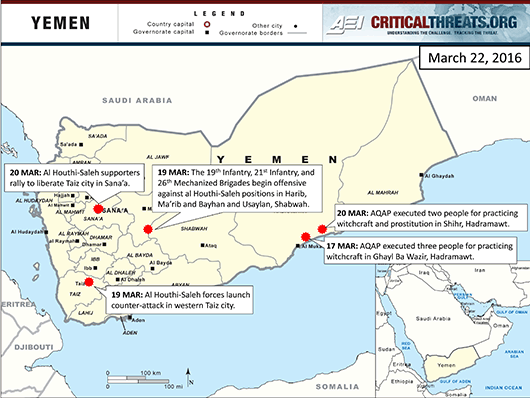The announcement that there will be a ceasefire in Yemen as a step toward resuming political negotiations generated reactions on the ground as warring parties seek to cement gains in advance of talks. Taiz remains contested and coalition-backed forces are advancing against the al Houthi-Saleh forces in southern Ma’rib and northern Shabwah governorates. The full implementation of the ceasefire’s terms, which remain unclear, may once again impede the start of negotiations.
Yemeni officials reported that the al Houthis and Abdu Rabbu Mansour Hadi’s government have agreed to a ceasefire in advance of the next round of political negotiations. Representatives from both sides met in Sana’a on March 20 with the UN Special Envoy to Yemen, Ismail Ould Cheikh Ahmed. Ismail Ould Cheikh Ahmed was in Sana’a for a three-day visit after meeting with President Hadi in Riyadh on March 18. The al Houthis agreed to implement UN Security Council Resolution 2216, which requires the al Houthi forces to disarm and withdraw from seized territory. Former president Ali Abdullah Saleh’s aide drafted an editorial on March 22 that distanced Saleh’s faction from the al Houthis, probably as part of Saleh’s continued bid to cut a deal with the Saudis. Talks are expected to occur in April, though they have been delayed since the first round broke down in December 2015. Hadi’s foreign minister, Abdul Malik al Mikhlafi, expressed confidence that talks would resume in Kuwait by the end of the month. Previous ceasefires have collapsed over allegations from each side that the other had violated terms. The Saudi-led coalition’s spokesman, Saudi Brigadier General Ahmed al Asiri, said on March 17 that major fighting was “near an end” in Yemen. Mass demonstrations are expected in support of both sides of the war on the one-year anniversary of the start of the coalition airstrikes on March 26.
Both al Houthi-Saleh forces and coalition-backed forces are mobilizing to Taiz. Al Houthi-Saleh supporters in Sana’a held a rally calling for the liberation of Taiz on March 20. The al Houthi-Saleh commander of Yemen’s Fourth Military District, UN- and U.S.-sanctioned Major General Abdullah Yahya al Hakim, was among the speakers and called for fighters to go to Dhubab and Umari in Taiz governorate. Hadi’s vice president, Khaled Bahah, called for the liberation of all Taiz cities and for the reinforcement of the brigade currently deployed in Taiz in a meeting in Aden on March 21. The southwestern entrance to Taiz city remains open after coalition-backed forces broke through the frontline a week ago. Al Houthi-Saleh forces launched a counter-attack on March 19 in western Taiz that killed 35 people on both sides.
Pro-Hadi government forces advanced the frontline in southern Ma’rib and northwestern Shabwah governorates. The commander of the 21st Mechanized Brigade, Brigadier General Jahdel Hanash al Awlaki, announced an offensive to seize and secure Bayhan district in northwestern Shabwah on March 19. The 19th Infantry Brigade, under the command of Brigadier General Musfar al Harithi, advanced to secure Usaylan district to the northwest of Bayhan district in Shabwah, and the 26th Mechanized Brigade, under the command of Brigadier General Mufrah Bahibah, advanced to secure Harib district in southern Ma’rib. Coalition forces provided air support for the offensive. Local popular resistance forces cooperated with the army troops.
Al Qaeda in the Arabian Peninsula (AQAP) continues to demonstrate control over Hadramawt’s coastal population. AQAP militants publicly executed three people convicted of practicing sorcery in Ghayl Ba Wazir, Hadramawt, on March 17. The group had announced the sentencing over a loudspeaker from a “Hisbah” car. Hisbah is an Islamic concept of accountability in which the government can coerce subscription to shari’a. AQAP militants executed two others in Unity Stadium in Shihr district in Hadramawt. One person had been convicted of practicing witchcraft and the other had been convicted on charges of prostitution and distributing alcohol.
The Hadramawt Tribal Confederation, an anti–al Houthi-Saleh and –AQAP group, announced its intent to reform as an umbrella organization for groups in Hadramawt. The group issued a statement on March 16 that explained the changes and called for its re-branding to the Hadramawt Confederation. Hadhrami representatives from civil society and other community groups signed the statement. The Hadramawt Confederation met again on March 19 to form committees—one for the coast and one for Wadi Hadramawt. The Hadramawt Tribal Confederation mobilized against AQAP briefly in April 2015.
The war in Yemen has created security and governance vacuums that subnational actors, including AQAP, are attempting to fill. AQAP has expanded significantly and is creating conditions in which smaller groups are unwilling to resist it to prevent its further growth or roll back gains over the past year.
Jon Diamond contributed research for this report.

